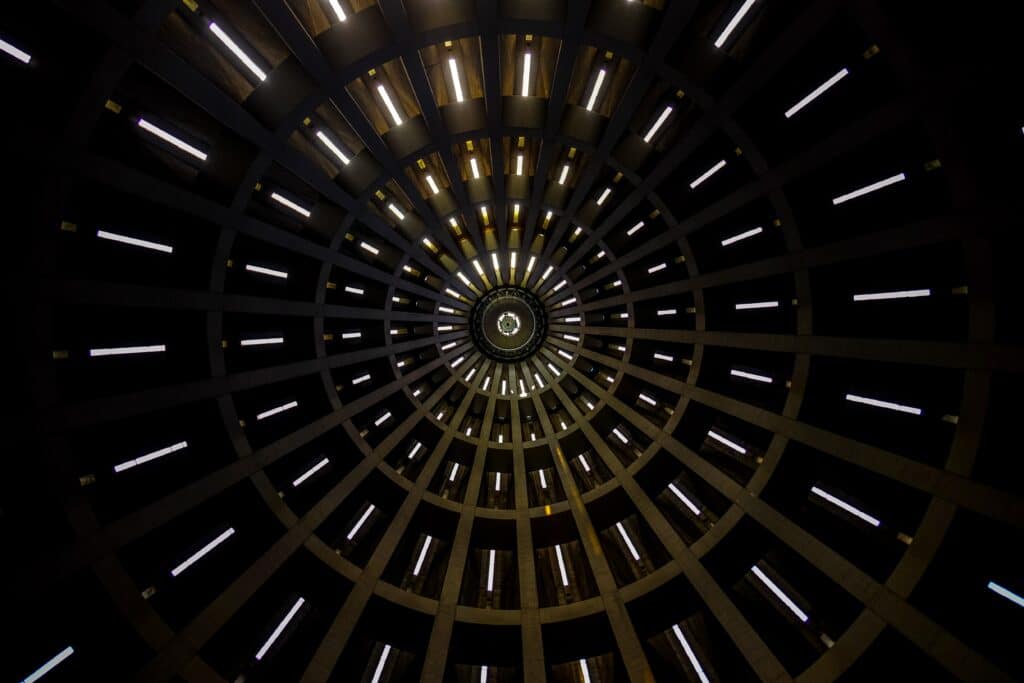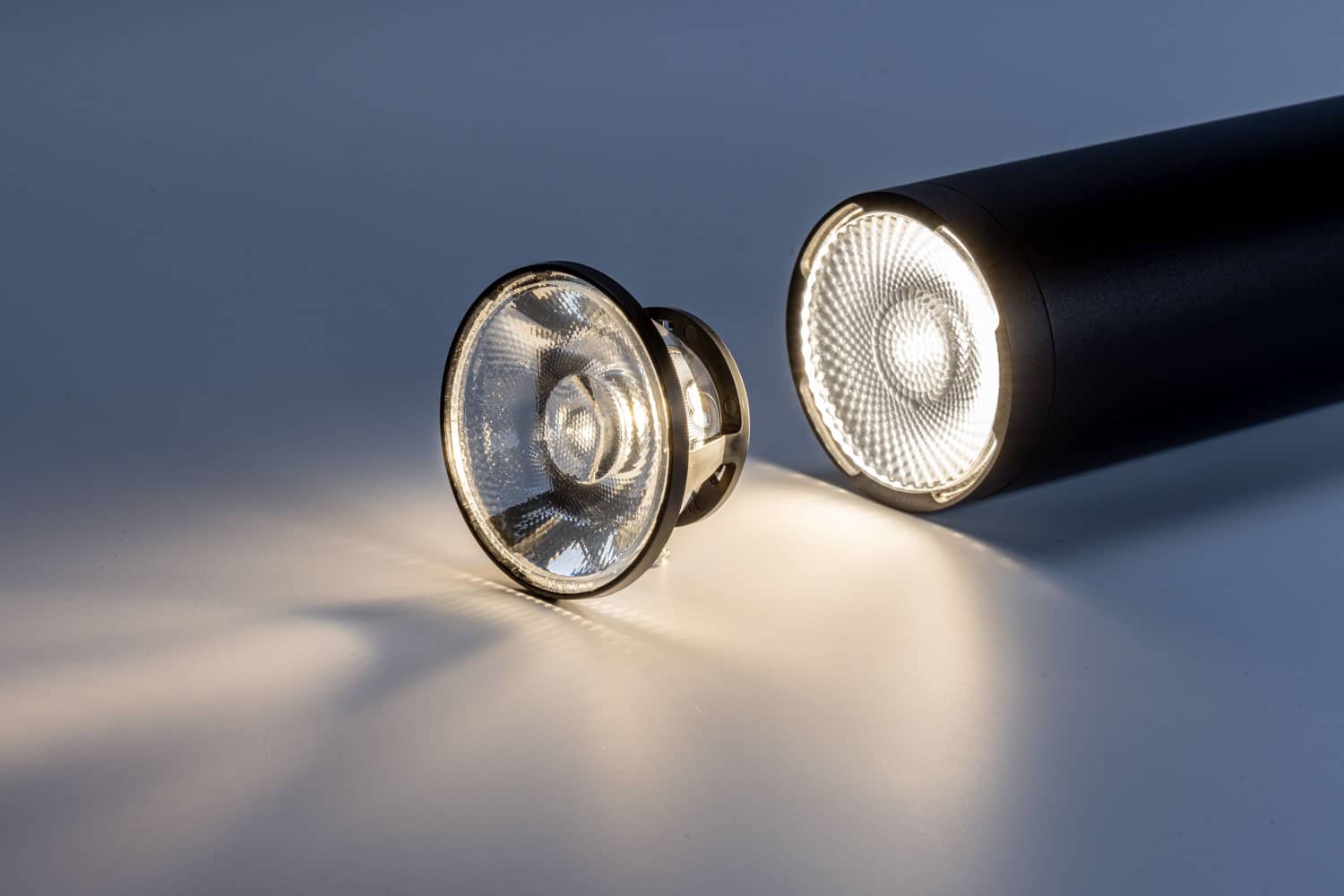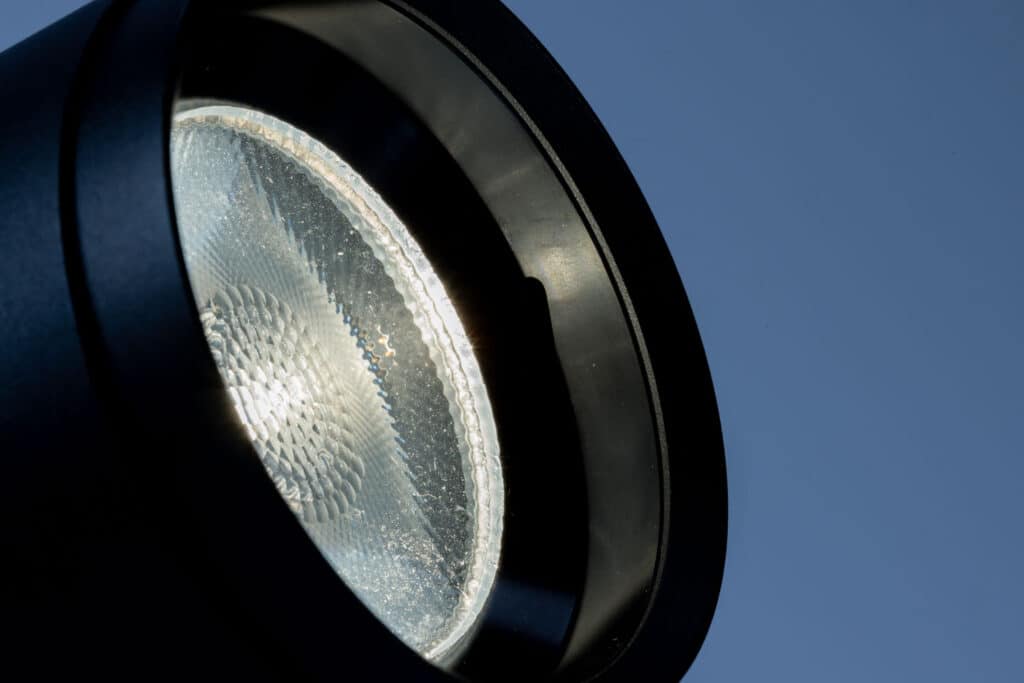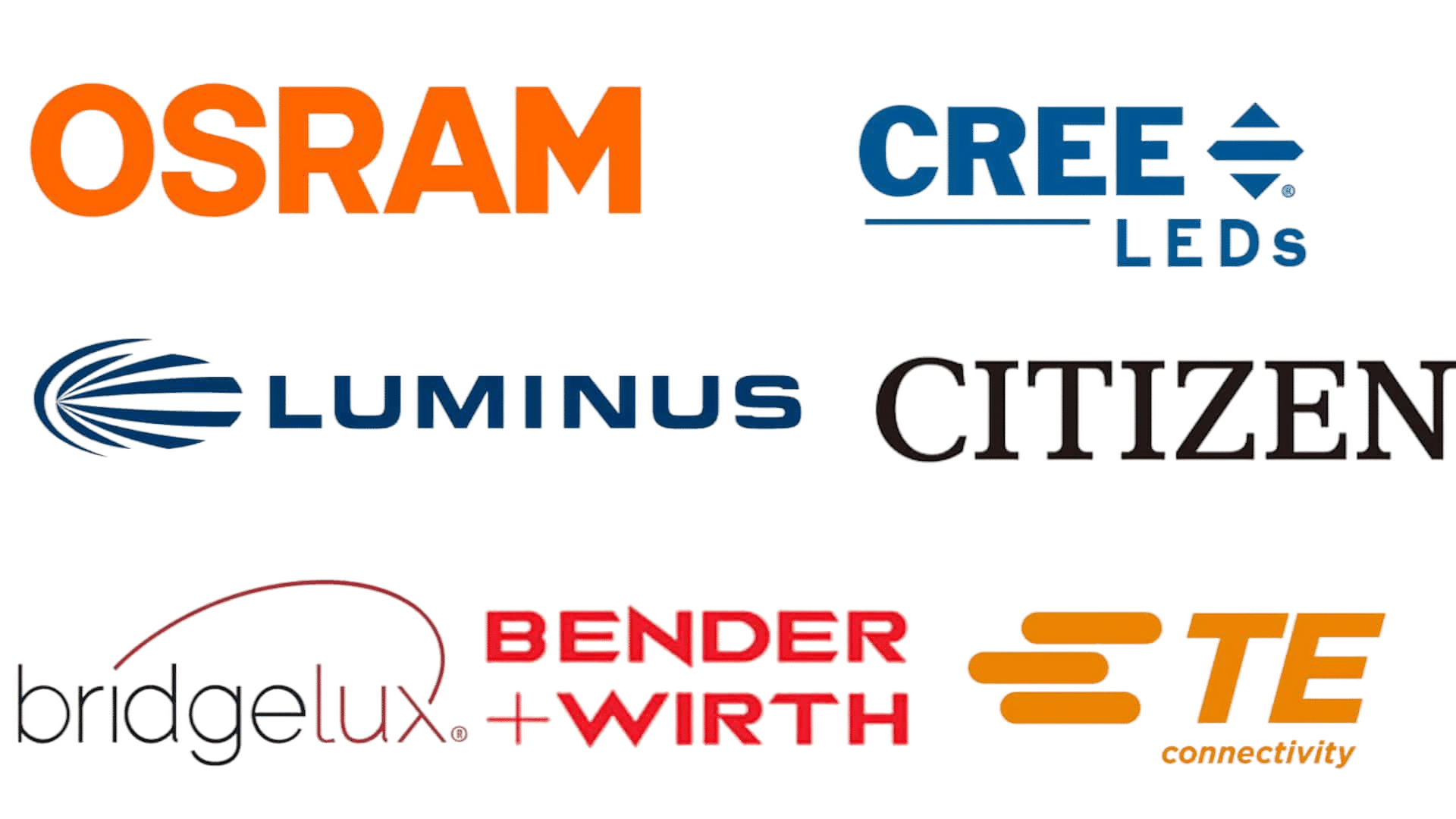Home > Knowledges > Why choose LED lighting?
Reading time : 9 minutes
Last update : may, 2023
LED Lighting, what is it?
A LED is an electronic component that emits light when electricity is passed through it, it is an acronym for “light-emitting diode”. It was first created in 1962 by Nick Holonyak Jr and S. Bevacqua and is used today in many fields for its numerous advantages.
How LED lights work?
Types of LED lighting
There are different types of LED installations used in lighting, including :
- Dual In-Line Package (or DIP) LEDs: The DIPs are the oldest types of LEDs still used today. One of the main advantages of this type of LED lighting is its sturdiness and ability to resist chocs due to its cylindrical dome-shaped resin coating. This type of LED is great for outdoor uses (advertising displays), however, they can only produce a single tone of color or light and are often used by 3, to recreate an RVB pixel. They are now used only for very specific projects because they are very expensive and become obsolete in the face of new technologies. They are useless in the fields of lighting and imaging.
- Surface Mounted LED (or SMD) LEDs: A surface-mounted diode is a type of LED that emits light and is completely flat on the surface it is mounted on. It consists of one or more square chips. This type of LED has many advantages including a smaller size, a lower cost, and an improved light diffusion. Unlike Dual In-Line Package LEDs, the Surface Mounted does not have a diffuser which allows for a better beam angle. It is the most used technology today, and is ideal for lighting.
- Chip-scale package (or CSP): It is a smaller chip technology with a very high intensity. There are three main types. The High-Power LED type uses SMD technology. It is the most powerful type of LED in terms of light density and light output. Some LED manufacturers offer simplified high-power LEDs, which are smaller and have plastic rather than ceramic housing to reduce cost. If you want less light intensity and a wider angle, Mid-Power LED and Low-Power LED solutions also exist.
- Chip on Board (or COB) LEDs: A COB is an LED assembly technology that describes the mounting of multiple LED chips directly on a substrate to form a single module. It is a more efficient way to use space as opposed to DIP, which can host 9 LEDs on a 1 cm² surface, and SMD, which can host 40, a Chip on board assembly can host 342. They are favored for their efficient use of space, high intensity, and high uniformity. It is usually presented as a yellow round chip in a white square pre-mounted on a PCB. This technology has been designed to be assembled with ease.
- We are also seeing more and more hybrid products coming out. As the market evolves, LED manufacturers must innovate . Examples: Bridgelux, Vesta® Series Tunable White.
LEDs are semiconductors, a category between conductors and insulators. A material said to be a conductor is a material that allows an electric current to travel through it (iron, aluminum, copper, gold…), an insulator does not (plastic or glass for example). These materials are made out of two energy levels also called bands: the valence band and the conduction band. In conductive materials, these two bands overlap, in the semiconductors, they are close and in an insulator, they are distant.
In semiconductors, the use of a high enough voltage allows the electrons to travel from the valence band to the conduction band, however, as the valence band loses an electron it now has a “hole”. The conduction band has gained the electron which allows the electric current to travel through the electric system. Because it is unstable, the hole in the valence band has to be filled. Therefore, when the semiconductor is traversed by a current, some electrons rise in the conduction band and others fall back into the holes of the valence band continuously. Each exchange of electron between the two (known as recombination) bands a photon which is the source of the light-emission.
The light emitted by the semiconductor is monochromatic. Production of white light is obtained as follows. The semiconductor emits a blue monochromatic light. A fraction of this light is absorbed by a fluorescent material called the phosphor. Then the phosphor emits yellow light back and this yellow light combined with the unabsorbed blue light creates white light.

Why should you use LEDs?
LED lighting has many advantages:
Electrical consumption: Unlike more traditional means of light production, LEDs use electric current to create light directly. When for example, incandescent bulbs produce both heat and light; LEDs solely produce light, which is why they are considered a better option for lower electrical consumption.
This lower electrical consumption is also directly linked to a cheaper, more economical way of producing light. In comparison, when a halogen uses 500 KWh for 10,000 hours of lighting, an LED only uses 50 or consumes 10 times less than the halogen.
Efficiency: Unlike Halogen and incandescent bulbs, LEDs produce very little heat, in comparison, when an incandescent bulb uses 90% of the energy it’s given to create heat, LEDs use almost 100% of it to create light. Moreover, LEDs produce 100 lumens per watt, while incandescents produce only 10 to 18. LEDs are also space-efficient and can be put together on a small surface and still produce a large amount of light.
Life Span: LEDs are the most sturdy and durable light sources, providing on average 50,000 hours of usage compared to 1,000 to 2,000 for incandescent bulbs and approximately 10,000 for compact fluorescent bulbs. This can be translated to 4,167 days (11.5 years) for a 12 hours a day usage and 2,083 days (5.7 years) for a 24h usage.
This long lifespan is due to the material used to build this type of light and the method of light creation as stated earlier.
Prices and Investment: Even though the first upfront investment, as well as installation cost, are more important with LED lights than other types of bulbs, the electrical consumption of LEDs is so low compared to halogen and incandescent that it is quickly amortized. Their longer life span also means that you do not have to replace them as often as you would an incandescent or halogen.
It is also important to note that over the past few years, the initial cost of LEDs lights decreased, especially with the advent of COB, making them quite affordable today.
Safety: Unlike incandescent bulbs, LEDs do not have a filament, so the heat emitted is much less. Since LEDs do not use temperature as a means of producing light, there is less risk of burns, heat-related injuries, and fire, and because they can operate on fewer watts, they can effectively function on low voltage electrical systems. In addition, most LED lamps and bulbs are made from high-quality plastics and other environmentally friendly materials, which makes them stronger and less likely to break, thus reducing the risk of injury and cuts from a broken bulb.
They are also free of mercury and many other hazardous chemicals (used in incandescent andhalogen, mercury is a highly toxic component).
Finally, they do not produce UV light, which makes them safer in the long run, as UV light has been proven to cause various skin problems such as wrinkles, skin irritation, and many others.
Control: LEDs give the user more control over the light they produce than any other mass-produced light source. LEDs do not need time to turn on and are dimmable at will, allowing total control over the appearance of the light. LEDs can be tuned to give warm or cool white types (tunable white) and an infinite range of colors while producing high-quality light (RGBW). Another advantage of LEDs is their excellent CRI (color rendering index) which allows for excellent color rendering on any surface. The overall look of the installation is also customizable as they fit on a smaller surface than their counterparts. The design of their diodes allows them to focus the light beams in a specific direction.
📌 Summary of the differences between lighting technologies :

What is a disadvantage to LEDs?
Here is a list of the main disadvantages of LEDs. Note that some LED manufacturers have already managed to remove some of them from their products.
- High initial costs
- Possibility of color change during the life of the LED
- Blue light emission is higher than other solutions
Applications
We will now focus on how we can use LEDs in different settings and why they might be interesting in some fields of application , one of our areas of expertise being the customization of optical products for different uses. Please note that for the following application areas, the lighting consists of the pairing of an LED and an optical element such as a collimator, a lens… You can find out here the recommended collimators according to the fields of application.
In general
- The energy efficiency and life span allow for less frequent replacements and therefore save costs.
- LEDs do not attract insects as they do not emit UV rays, which is appreciated for lighting close to houses, buildings, crops and fields, streets, etc…
- Sturdy LEDs can stand for long periods in difficult weather conditions and are incredibly resistant to cold temperatures.
- Safer, the lack of heat and usual sturdiness of the bulb make them safer for handling, kids, and many outdoor uses.
Outdoor uses
For leisure: LEDs are used in leisure, for example in headlights, because they can function with small batteries, produce an intense beam of light with few LEDs necessary for certain activities (biking, hiking, climbing, caving…), are light, easily transportable, and have a long life span.
For obstruction, safety, and road lighting: The wide range of colors available with RGBW LED, especially red and green as well as their visible intense beam, make them very useful for signaling. They are used for example in sensors, flashing lights, railroad crossings, wind farms, and lighthouses, to signal a position, an emergency, or a piece of information…
Indoor uses
For greenhouses: Depending on the type of LED you choose to use, this lighting technology can help you grow higher quality and stronger plants. Because LEDs and the light they produce are so customizable, it allows you to perfectly control light levels, type of light, uniformity, and time of exposure.
For offices: Because of its cooler appearance, researchers found that LED lighting increases productivity by mimicking natural light: LEDs can also be programmed to follow the circadian rhythm. Unlike other means of light production, LEDs do not generate noise and therefore using them reduces the noise pollution in the office.
According to the National Institute of General Medical Sciences “Circadian rhythms are physical, mental and behavioral changes that follow a roughly 24-hour cycle, responding primarily to light and darkness in an organism’s environment.”
For hospitals, imaging, and medical lighting: Just as LEDs are used in offices because they can be programmed to follow the employees’ circadian rhythm, it is used in hospitals to follow doctors’, workers’, and patients’. This method is used to better the lives of patients and not disrupt their habits.
LEDs are also used because, unlike Fluorescent light, they are non-toxic and do not contain harmful chemicals such as mercury. They also do not produce UV lights, as UV lights, with prolonged exposure, can cause skin damage. In the operating rooms, the high CRI (color-rendering indexes) of LEDs gives the hospital staff a clear and accurate vision of colors, very important in a medical setting. Moreover, as many LEDs are dimmable, it allows patients and health workers to adjust them to their needs or sensitivities.
Finally, their prolonged life span and overall durability ensure lighting for a longer time and fewer replacements, allowing hospital workers to work in better conditions.
For stores: LEDs are ideal for product display and shelf lighting, as they do not generate heat and therefore do not damage the products, they allow for multiple colors, and the cool appearance of the light highlights the product.
For stage lighting: Professionals started using LED lights because not only they are more cost-efficient (meaning a lower cost production), but they also produce less heat, which offers a safer, more enjoyable environment for the people near them. The increased brightness of the LED lights allows for better lighting in general, an enhancement of the stage as well as multiple different colors allowing better performances.

LED & GAGGIONE
At Gaggione, our optics work with LED technology.
In fact, our products shape the light emitted by the LED to produce a light beam that is more or less intense, wide or narrow, etc. This means that our standard lenses can be adapted to numerous fields of application as well as their respective standards.
Thus, the knowledge of this sector is essential in our business. We are aware that, depending on the type of LED, the manufacturer, or even the reference, our lenses behave differently. That’s why we offer a LED search engine on every product page. This will allow you to identify the behavior of a lens according to each LED reference and give you useful information such as efficiency, FWHM 1 and 2, and color index consistency. Because of the importance of this information for our customers, our dedicated team of optical experts performs these measurements and simulations themselves,in our in-house laboratory.
OUR PARTNERS FOR YOUR OPTICAL SOLUTIONS
We are proud to be considered as a valued partner by the most influential brands in LED lighting industry. Whether they are LED manufacturers or component suppliers, they are the people with whom we interact on a daily basis to make your life easier and improve your products.


